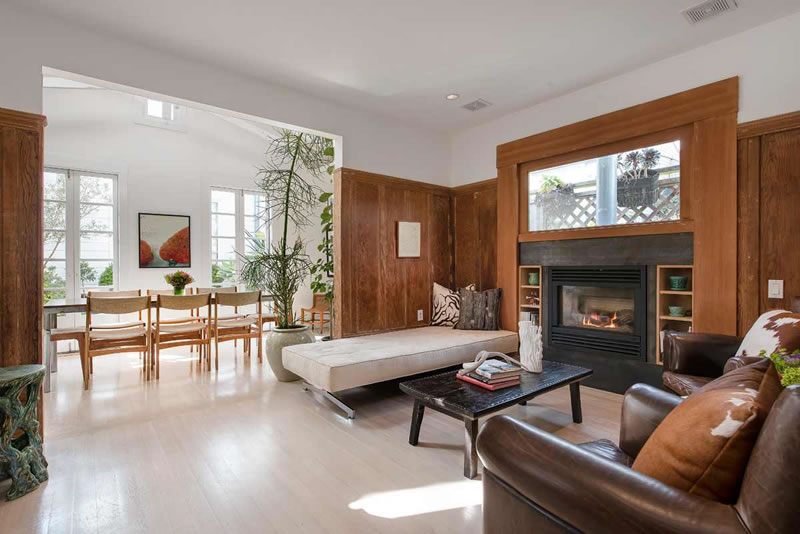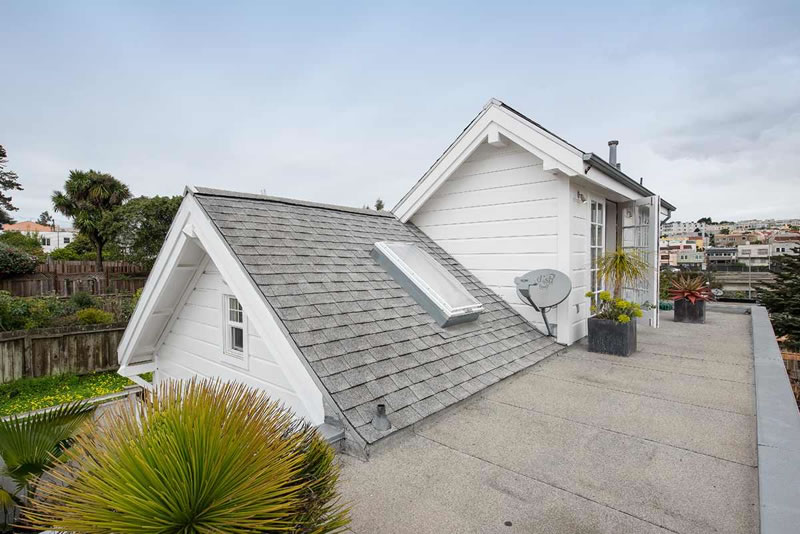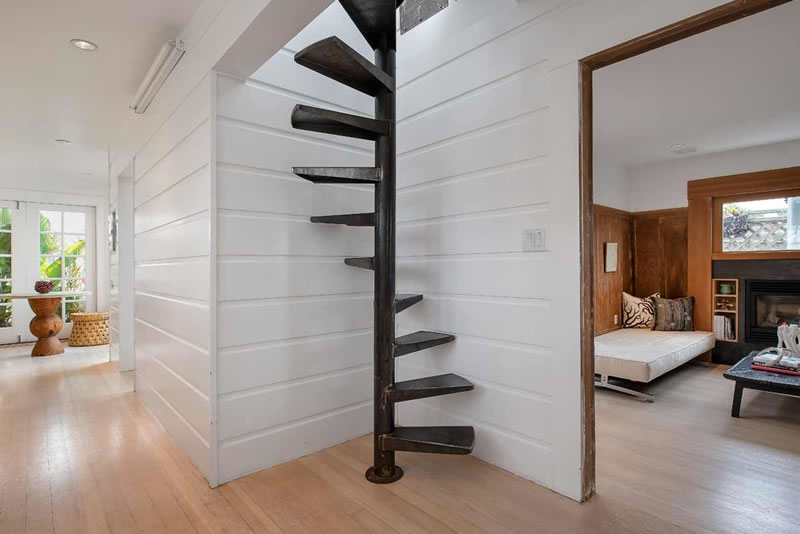Purchased for $565,000 in 2007 having been rebuilt by architect Ian Murray in 2005, the setback Excelsior District cottage at 247 Ney Street returned to the market last month listed for $859,000 and has sold for $991,800 ($902 per square foot).
As we wrote about the property last month: “A steel staircase leads to the second bedroom, with exposed wood ceilings, skylights and another set of French doors which open to the roof.”
Speaking of which, a complaint about the lack of guardrails around the roof has since been dismissed (“this is a roof area not a deck per plans”).
A complaint about the lack of a railing around the staircase is pending an inspector’s ability to gain entry.



Shabby sheik is back?
sheik or chic?
Definitely chic not sheik. No room for a harem in this house.
You can spot Shabby Sheiks at the Bahrain airport early in the morning after a weekend binge. They still reek of Hennessy as they board the flight to Riyadh.
Great! Congratulations to the new homeowner and welcome to the neighborhood. Enjoy living in your nice, bright, and cozy home. Ignore the whole brouhaha about the inside staircase, who cares? Your home is your castle.
It is chic, not sheik (means “The Honorable” in Arabic and pronounced as “shake”)
Yeah I know…frickin typo…8am is too early in the morning for me.
So by calling it a roof instead of a deck, you can skirt the safety requirements? Lovely. I hope they have good liability insurance.
fake caring enough to write a snide comment is so not awesome
They don’t call it a roof, it is a frickin roof. Too dangerous, don’t go out on it! Have kids? Lock that door, or change it to a window. Shees.
I wish I could have a kind of staircase or something that directly opens to the roof. Then I can easily troubleshoot, maintain, and do minor roof repairs myself instead of solely relying on roofers.
I think it’s fine, but it’s a shame that one million now seems to be near the bottom of the market for a single family home in the city. You either need to have the cash or an income of around $350,000 per year to buy this. Goodbye middle class!
This sales is not really representative. The median price across SF is $1.09M. This one must be at the high end in Excelsior. Someone really love this cottage.
But yes it is so hard to be in San Francisco if you don’t make loads of money. I happened to talk to a Uber driver coming in from Fresno to drive Friday and Saturday in San Francisco. He was talking about how he can only afford a house for his big family there.
Of course, there are a lot of good places to live that are not single family homes. And there are even more good places to live that are not in San Francisco. I agree that the cost of SF housing is a real issue, but I’m not certain there is a critical “middle class” problem. An anecdote. We had work done on one of our decks a few weeks ago, and the contractor drove up from Salinas each day – said most of his jobs are either in SF or San Jose. He did not seem to mind (I’d never do that drive, but some people don’t mind driving long distances). Based on what we paid him, I’d say he makes close to six figures or a little more, and he has a new-ish 4BR house in Salinas. On his income, he could easily afford a decent place in Oakland or, say, Concord, and avoid that long haul. But he preferred a bigger home farther away.
What is wrong with that? This is really a policy issue – do we want SF residents to be nearly all upper or upper-middle class? That is not necessarily a terrible outcome. Pac Heights has had this type of population for decades, and yet their shopkeeping and plumbing and nanny and housekeeping etc. needs get met. The workers come from outside the neighborhood. Not that different to extend that SF-wide. Personally, I don’t think that is a desirable outcome (for a lot of reasons), but I don’t think this would be objectively “bad.” Solid arguments can be made that the upside to a wholly gentrified city outweigh the downsides. This is the question that needs to be addressed rather than making lots of local, willy-nilly decisions without addressing the broader topic. Is it a bad thing if the “middle class” and lower classes cannot afford to live here? People have assumed the answer to that question is “of course” without any quality debate.
Nothing is wrong with that. I like it. Inspires me to reach higher goals. I was in the Outer Mission this afternoon to meet and have lunch with a family friend. He is a tax preparer with his own shop servicing mostly working class middle-aged to older monolingual Spanish speaking clients. All of his clients seemed happy about life, family, and their sense of well being. No one felt angry about being displaced by newcomers.
Happy…because they have rent control in SF?!?!
Baahhaahaa!
I think you point out the exact problem in your comment, Pac Heights. It’s a nice area and they have their services met but from the standpoint of urban culture it’s vanilla, dull and almost suburban which defeats the purpose of why so many of us live here. The people being displaced aren’t just your contractor who chooses to commute several hours a day to his 4 bedroom home down south (that sounds terrible to me) but the creative class of people that make this city so interesting, the artist, musicians, writers, actors, etc who are moving to Oakland in droves and taking their culture with them. We either need to create better public transit like NYC so that SF can remain a cultural center or we need to provide affordable housing so that those that contribute to the vibrancy of this city in ways other than money can continue to contribute to it’s greatness.
You nailed it. Pac Heights is might as well be Lafayette without the big lawns.
It’s great time for Oakland/Berkeley – neighborhoods that were formerly boarded up ruins are coming back to life; downtrodden blocks have turned into lively, entertaining streets, as SF residents relocate. If you enjoy that culture, move with it – it’s only a few minutes Bart ride away. Civilizations and settlements have been dramatically fluid throughout human history. Enjoy the changing times.
The problem is that the lack of lower cost housing in SF and elsewhere in the inner Bay Area causes intense and rapidly worsening traffic. We are headed for LA-levels of immobility and loss of freedom within about 10 years.
Actually, we have long ago exceeded Los Angeles levels of commute durations and traffic congestion.
Atlantic Cities did a whole article about how the Bay Area has the longest commute times in the country, and worse still, some of the longest distances travelled by commuters. Many would be surprised to the learn the Los Angeles area has a much higher density than the Bay Area. We all love pointing fingers to North Beach density and comparing ourselves to Manhattan, but the reality is that the Bay Area is as sprawling as many of the urban areas we pretend we are not. I am more than aware of this as I have clients and projects around the entire Bay Area and experience the congestion they suffer even though I live in the Marina and can work out of my home on most days.
Our congestion is due to a combination of concentrated employment zones (downtown SF, north Silicon Valley), NIMBYism, unwillingness to change, and being short on space. There’s no room to make the roads wider so the NIMBYs oppose denser development because it will make roads more congested. This could be solved by more efficient transit but we’re both unwilling to invest and reluctant to switch.
In the mean time sprawl continues into the exurbs. Those people drive into the inner Bay Area for work and congestion gets worse anyways.
The best way I can see out of this stalemate is to stop placating the anti-density crowd. Congestion is going to get worse whether or not we build housing in the inner Bay Area. But commute distances will be a lot shorter from infill developments and they set the stage for better transit. Finally.
Leave well enough alone.
Wow, $900 a sq/ft in Excelsior, I also just heard about a house that sold for $800 sq/ft in Bayview, things are really changing in long ignored SE SF. With the relatively high rate of home ownership in these areas, it will be interesting to see how the neighborhood changes as a lot of lower income people are finding themselves sitting on nearly, or soon to be, million dollar properties and many may want to cash out and retire somewhere much cheaper which could create faster change than areas where those with little money are in protected rentals. It will be interesting to see because you still get a lot for your money in Excelsior, Portola, Silver Terrace, Bayview & Vis Valley and after living down here myself for a year now, it’s pretty underrated and a much nicer and convenient place to live than most think, we have been very surprised by how much we like it.
Yeah, this is the flip-side of Mark F’s comment that it is a shame these places now cost a million bucks. That means a lot of long-time owners can now have a very nice retirement (and estate) rather than a struggle. And the higher property taxes are good for the city finances along with a lot of other plusses.
This kind of appreciation and change can beget more appreciation and change pretty quickly. I saw it in my old neighborhood a little over a decade go. New, much wealthier residents started moving in. Older, poorer residents either sold (and cashed out) or were evicted. At some point, it reached a tipping point where a formerly “bad” neighborhood was now pretty desirable, then very desirable, and the turnover accelerated. Result was a huge change in the character of the neighborhood in only about 5-7 years. This can work in the other direction too, as many cities saw in the 60s-70s, and on balance it’s hard to complain that SF is moving in this direction (although there are certainly many who get left out or kicked out in the process).
do you live in Bernal? that sounds like Bernal Heights
It is a great place to live – recent resident here, too. Hopefully we can see some positive changes while keeping the flavor of the neighborhood intact.
Agreed! This corner of the City is getting some attention now. It’s perfect for GP Bart, and my commute. Glad we got here a few years ago, while it was affordable (at a big stretch!) for us.